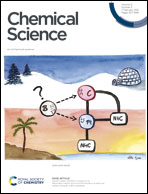Synthesis of N-aryl amines enabled by photocatalytic dehydrogenation†
Abstract
Catalytic dehydrogenation (CD) via visible-light photoredox catalysis provides an efficient route for the synthesis of aromatic compounds. However, access to N-aryl amines, which are widely utilized synthetic moieties, via visible-light-induced CD remains a significant challenge, because of the difficulty in controlling the reactivity of amines under photocatalytic conditions. Here, the visible-light-induced photocatalytic synthesis of N-aryl amines was achieved by the CD of allylic amines. The unusual strategy using C6F5I as an hydrogen-atom acceptor enables the mild and controlled CD of amines bearing various functional groups and activated C–H bonds, suppressing side-reaction of the reactive N-aryl amine products. Thorough mechanistic studies suggest the involvement of single-electron and hydrogen-atom transfers in a well-defined order to provide a synergistic effect in the control of the reactivity. Notably, the back-electron transfer process prevents the desired product from further reacting under oxidative conditions.



 Please wait while we load your content...
Please wait while we load your content...